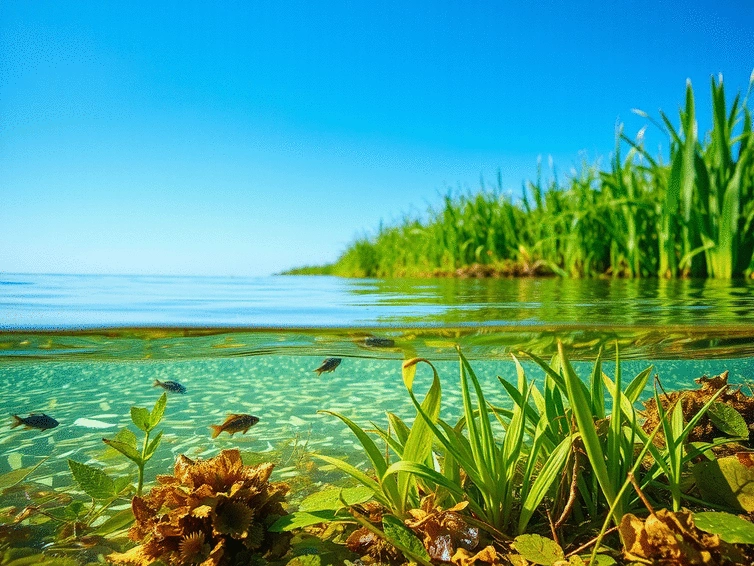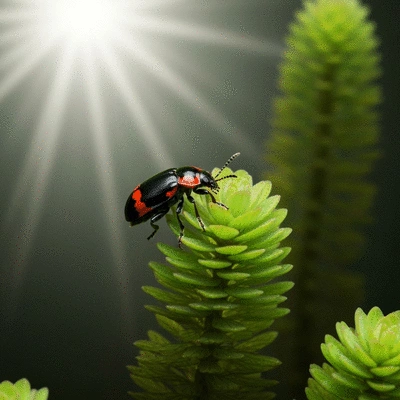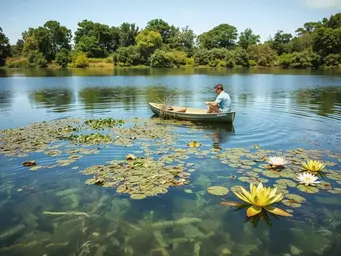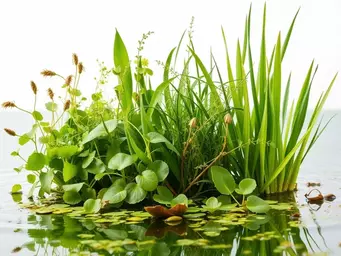Insect Biocontrol Agents
Insects like flea beetles and weevils specifically target invasive aquatic weeds, reducing their populations by feeding on them.
- Alligatorweed Flea Beetle
- Waterhyacinth Weevils

As we explore the world of aquatic ecosystems, it becomes increasingly clear how vital it is to manage invasive species effectively. One of the most promising methods involves harnessing the power of biological control agents. Could this innovative approach be the key to restoring balance in our waterways?
This visual illustrates the primary types of biological control agents used in aquatic weed management, highlighting their roles and benefits.
Insects like flea beetles and weevils specifically target invasive aquatic weeds, reducing their populations by feeding on them.
Fungi (Mycoherbicides) and bacteria infect and kill specific aquatic weeds, offering a targeted approach with minimal impact on native species.
Herbivorous fish like Grass Carp consume large quantities of aquatic vegetation, reducing invasive plant biomass and supporting native species.
Plant compounds that act as natural herbicides, attract beneficial organisms, or enhance the effectiveness of other biocontrol agents.
As passionate advocates for healthy aquatic ecosystems, we at Aquatic Weed Solutions recognize the challenges posed by invasive aquatic weeds. One of the most effective ways to tackle these issues is through the use of biological control agents. But what does this really mean in the context of aquatic environments? Let's dive in!
Biological control is the practice of using living organisms to manage pest populations, particularly harmful weeds, without the reliance on chemical treatments. This method leverages natural predators or pathogens to suppress invasive species. By employing biological control, we can restore balance to our waterways while minimizing ecological disruption. For further insights into the role of biological control, the USDA's annual report on biological control provides comprehensive details on various initiatives and their impacts.
In aquatic settings, biological control agents can include insects, fish, and microorganisms specially chosen for their effectiveness against specific invasive plant species. The goal is to create a self-sustaining control method that enhances the resilience of aquatic ecosystems.
By understanding these concepts, we can better appreciate how biological control contributes to the management of aquatic weeds and the overall health of our water habitats.

Biological control plays a pivotal role in the management of aquatic weeds by providing a sustainable alternative to traditional methods. Instead of relying solely on herbicides, landowners and managers can introduce biocontrol agents that specifically target invasive species, reducing their population naturally. This approach not only minimizes chemical use but also enhances the resilience of the ecosystem.
As I’ve seen throughout my work with landowners and ecologists, the introduction of biocontrol can lead to remarkable outcomes. For instance, less reliance on chemicals leads to healthier water quality and a thriving habitat for native species. The key here is to select the right biocontrol agents that are effective, safe, and compatible with local ecosystems. For more information on successful aquatic weed biocontrol projects, you can refer to resources such as Cal-IPC's symposium on aquatic weed biocontrol, which highlights various success stories and ongoing research.
Incorporating biological control into our management strategies ensures a more holistic approach to dealing with aquatic weeds, leaving our waterways healthier for future generations.
To maximize the effectiveness of biological control, it’s essential to integrate these strategies into a broader framework known as Integrated Pest Management (IPM). This comprehensive approach combines various management techniques to address pest problems in a sustainable manner. By doing so, we can ensure that our aquatic environments remain vibrant and diverse.
IPM encourages the use of biological control as one component among several, which might include mechanical removal and targeted chemical treatments when absolutely necessary. This balanced approach limits reliance on any single method and promotes the overall health of aquatic ecosystems.
By integrating biological control with IPM, we create a more robust framework for managing aquatic weeds while ensuring the ecological integrity of our waterways.
Understanding the various types of biocontrol agents is crucial for effective aquatic weed management. There are several categories of these agents, each with unique properties and advantages. Let's explore some of the most common types!
Insects are one of the most widely used biocontrol agents in aquatic environments. Certain species of insects are specifically targeted to manage invasive weeds, such as alligatorweed and waterhyacinth. These insects feed on the harmful plants, effectively reducing their populations over time.
In our experience, implementing insect biocontrol has yielded positive results. For example, introducing the alligatorweed flea beetle has proven effective in controlling alligatorweed infestations in various waterways. Similarly, the introduction of specific weevils has successfully managed waterhyacinth populations.
These real-world applications demonstrate the power of using insects as biocontrol agents in managing aquatic weeds effectively.
Another avenue for biological control is the use of pathogens, including fungi and bacteria, which can specifically target aquatic weeds. These agents can be applied to infested areas and work by infecting and killing the plants, reducing their overall spread.
Fungal pathogens, such as Mycoherbicides, have shown promise in controlling various invasive species. One of the benefits of using fungal and bacterial biocontrol agents is their specificity; they often target only the invasive plants, leaving native species unharmed.
Insect pathogens, like certain viruses and bacteria, can further support aquatic weed control by targeting insect populations that may contribute to weed spread. This multifaceted approach enhances the overall effectiveness of biological control in aquatic ecosystems.
Utilizing pathogens as biocontrol agents is an innovative strategy that deserves further exploration in our ongoing efforts to restore aquatic ecosystems.
Fish can also play a significant role in biocontrol, particularly herbivorous fish like grass carp. These fish consume large quantities of aquatic vegetation, making them a valuable tool in managing invasive weed populations.
Grass carp can help reduce the biomass of invasive plants, creating room for native species to thrive. This not only improves biodiversity but also enhances the overall health of the ecosystem, supporting various aquatic life forms. Recent advancements in using grass carp for aquatic weed control are continuously being researched, as detailed by the USDA Agricultural Research Service.
However, using fish for biocontrol comes with its own set of ecological considerations. It’s essential to ensure that the introduction of grass carp does not disrupt existing ecosystems or outcompete native fish species. Proper assessments and management are crucial.
Utilizing fish as biocontrol agents can be a powerful strategy, but it’s essential to proceed thoughtfully to protect our aquatic ecosystems.
As we work towards effective aquatic weed management, community involvement is crucial. Have you considered how your local community can play a role in managing invasive species? Engaging local stakeholders can amplify the success of biocontrol efforts. Share your thoughts on how you think communities can better collaborate in these initiatives:
Understanding the role of biological control agents is crucial for sustainable aquatic weed management. These natural solutions not only help manage invasive species but also promote ecological balance within waterways. By utilizing biocontrol methods, we can reduce our reliance on synthetic chemicals, which often have detrimental effects on both the environment and non-target species.
For me, as an ecologist, the importance of biological control lies in its ability to maintain healthy ecosystems. When we introduce natural predators or pathogens to combat invasive aquatic weeds, we take significant strides toward restoring the natural order of these habitats. This approach has proven to be effective in various case studies and real-world applications.

Biological control agents serve as an essential pillar in the realm of sustainable aquatic management. They offer several benefits:
In my experience, integrating biological control with other management strategies can create a holistic approach that promotes the longevity of our aquatic ecosystems. As we witness positive outcomes, it becomes clear that biocontrol is not just a temporary fix; it's a sustainable solution.
When considering the implementation of biological control agents, here are some key takeaways:
These takeaways reflect my commitment to empowering individuals and communities with knowledge, so they can effectively manage their aquatic ecosystems. Together, we can achieve significant improvements in aquatic health!
Phytochemicals, the natural compounds produced by plants, play a vital role in the management of aquatic weeds. They can influence both the growth of invasive species and the effectiveness of biological control agents:
By understanding and harnessing the power of phytochemicals, we can improve our biocontrol strategies, leading to healthier aquatic environments for all species. This integrated approach is what I strive to promote through Aquatic Weed Solutions.
Community engagement is fundamental to successful aquatic weed management. As individuals who care deeply about our ecosystems, we can support and foster local initiatives that focus on sustainability and health.
Participating actively within our communities not ably enriches our understanding but also strengthens our collective impact. Together, we can pave the way for more effective and environmentally sound management practices!
There are numerous ways to engage with your local community on aquatic management initiatives:
These actions not only broaden our understanding but also create a network of individuals dedicated to preserving our precious aquatic resources!
Sharing success stories and best practices can inspire others to take action in their own communities. Here are some ideas to encourage this sharing:
By sharing knowledge and celebrating achievements, we can foster a culture of collaboration that enhances our collective efforts in managing aquatic ecosystems!
Raising public awareness about invasive species and the role of biocontrol is crucial for encouraging proactive management. Here are some ways to promote awareness:
In my journey with Aquatic Weed Solutions, I've seen how informed communities can make significant strides in managing their natural resources. Together, let’s promote awareness and drive positive change for our aquatic environments!
Managing Aquatic Weeds Effectively

As we delve into the hidden challenges of our water ecosystems, understanding the role of aquatic we
Impact of Aquatic Weeds on Recreation

As we dive into the world of aquatic ecosystems, the presence of invasive aquatic weeds may not only
Understanding Aquatic Weed Varieties

What if understanding aquatic weeds could be the key to restoring our waterways? As we dive deeper i
Managing Aquatic Weeds Effectively
Impact of Aquatic Weeds on Recreation
Understanding Aquatic Weed Varieties
Integrated Aquatic Weed Management Methods
Integrated Approaches to Aquatic Weeds